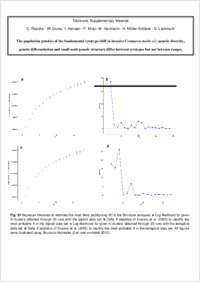The population genetics of the fundamental cytotype-shift in invasive Centaurea stoebe s.l.: genetic diversity, genetic differentiation and small-scale genetic structure differ between cytotypes but not between ranges
- Rosche, Christoph Institute of Biology/Geobotany and Botanical Garden, Martin Luther University Halle-Wittenberg, Germany - Department Community Ecology (BZF), Helmholtz-Centre for Environmental Research – UFZ, Halle, Germany - Herbarium and Department of Botany, Faculty of Science, Charles University in Prague, Czech Republic
- Durka, Walter Department Community Ecology (BZF), Helmholtz-Centre for Environmental Research – UFZ, Halle, Germany - German Centre for Integrative Biodiversity Research (iDiv) Halle-Jena-Leipzig, Germany
- Hensen, Isabell Institute of Biology/Geobotany and Botanical Garden, Martin Luther University Halle-Wittenberg, Germany - German Centre for Integrative Biodiversity Research (iDiv) Halle-Jena-Leipzig, Germany
- Mráz, Patrik Herbarium and Department of Botany, Faculty of Science, Charles University in Prague, Czech Republic
- Hartmann, Matthias Herbarium and Department of Botany, Faculty of Science, Charles University in Prague, Czech Republic
- Müller-Schärer, Heinz Department of Biology, Unit of Ecology and Evolution, University of Fribourg, Switzerland
- Lachmuth, Susanne Institute of Biology/Geobotany and Botanical Garden, Martin Luther University Halle-Wittenberg, Germany - German Centre for Integrative Biodiversity Research (iDiv) Halle-Jena-Leipzig, Germany
-
30.03.2016
Published in:
- Biological Invasions. - 2016, p. 1–16
English
Polyploids are overrepresented in invasive species. Yet, the role of genetic diversity and drift in colonization success of polyploids remains unclear. Here, we investigate genetic diversity, genetic differentiation and small-scale genetic structure in our model system, the three geo-cytotypes of Centaurea stoebe: monocarpic diploids and polycarpic (allo)tetraploids coexist in the native range (Eurasia), but only tetraploids are reported from the invasive range (North America). For each geo-cytotype, we investigated 18–20 populations varying in size and habitat type (natural vs. ruderal). Population genetic analyses were conducted at eight microsatellite loci. Compared to diploids, tetraploids revealed higher genetic diversity and lower genetic differentiation, whereas both were comparable in tetraploids between both ranges. Within spatial distances of a few meters, diploid individuals were more strongly related to one another than tetraploids. In addition, expected heterozygosity in diploids increased with population size and was higher in natural than in ruderal habitats. However, neither relationship was found for tetraploids. The higher genetic diversity of tetraploid C. stoebe may have enhanced its colonization abilities, if genetic diversity is correlated with fitness and adaptive capabilities. Furthermore, the inheritance of a duplicated chromosome set as well as longevity and frequent gene flow reduces drift in tetraploids. This counteracts genetic depletion during initial introductions and in subsequent phases of small or fluctuating population sizes in ruderal habitats. Our findings advocate the importance of studying colonization genetic processes to gain a more mechanistic understanding of the role of polyploidy in invasion dynamics
- Faculty
- Faculté des sciences et de médecine
- Department
- Département de Biologie
- Language
-
- English
- Classification
- Biological sciences
- License
-
License undefined
- Identifiers
-
- RERO DOC 260660
- DOI 10.1007/s10530-016-1133-2
- Persistent URL
- https://folia.unifr.ch/unifr/documents/304837
Other files
Statistics
Document views: 100
File downloads:
- pdf: 300
- Supplementary material: 127

